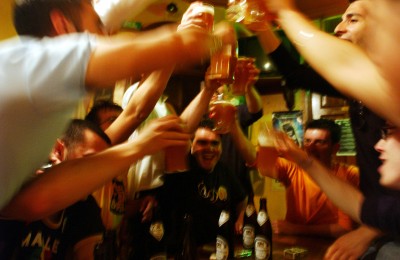It’s been a stressful week of school and work. It’s 9:00 p.m. on a Friday night and you’re looking forward to relieving some of that stress by going to a club with friends. As usual, your friends decide to meet at someone’s house to pre-game – share a couple of drinks, allowing time to catch up and get a buzz before stepping out, hopefully saving some money. You play one round of beer pong with the guys, have a couple of shots of vodka with the girls and mix some liquor in a soda bottle for the road. You arrive at the club by midnight, already intoxicated and slightly disoriented. However, you proceed to the bar to buy some more rounds, unaware that you already reached your limit.
For many college students, “pre-gaming” is a social drinking ritual. Friends gather an hour or two before heading out to a bar, club or lounge. In that short time, they drink large quantities of alcohol through drinking games or finish a bottle among a couple of friends. “My friends and I pre-game each time we’re going out, said Karina, a third year psychology major. “It’s a must. We meet at someone’s home, have a couple of cocktails while we’re getting dressed and before leaving to the party we take maybe two shots.”
While most students see it as a way to start the party early and save money, they may not realize that pre-gaming is also a way to mask alcohol abuse or binge drinking.
The Center for Disease Control and Prevention (CDC) defines binge drinking as consuming at least four or five drinks for women and men respectively during a two-hour timespan, bringing a person’s blood alcohol concentration to 0.08% or above. Sound familiar? When students pre-game, they are most likely binging early on in the night. A recent informal survey of CCNY students, conducted by Excelsior Mox, a student group from City College’s own MCA Ad/PR Workshop, revealed the unhealthy truth about this dangerous trend.
According to the Excelsior Mox survey, at least 25% of CCNY students engage in pre-gaming, with most students consuming at least four drinks, in addition to another four consumed at their social destination. This meets the CDC’s definition of binge drinking. While similarities between pre-gaming and binge drinking may seem evident, to many CCNY students pre-gaming is a harmless social activity with no negative implications. In fact, less than 1% of students surveyed described this pre-gaming behavior as a severe problem in need of monitor and control. Significantly, however, 34% of students described binge drinking as a ‘severe’ or ‘very severe’ problem on the CCNY campus. These survey responses confirm that students don’t acknowledge the harmful aspect that pre-gaming, which frequently leads to alcohol binging.
While students like to think of pre-gaming as a fun way to enhance their social experience they are under several misconceptions. One is that it boosts social confidence. Young adults believe that an alcohol buzz makes them more at ease in public settings and are more comfortable meeting new people. In reality, beginning their alcohol consumption earlier in the evening and continuing to drink throughout the night can lead them to become intoxicated, belligerent and socially unappealing – not a great way to make a good impression.
Another misconception is that students believe that pre-gaming saves money. New York City is one of the ten most expensive cities in the world, and the price tag of alcohol at bars, clubs and lounges proves no different. A drink in New York City can go for as much as $12, in addition to transportation costs and cover charges. By the end of the night, students spend a lot of money. This is why many see pre-gaming as a money saver. Purchasing bottles of alcohol at a store is relatively cheaper than rounds of the same alcohol at a bar. Since college students may already be intoxicated when arriving at their destination, they think they’ll buy fewer drinks. However, according to a 2006 Daily Finance article on college students’ spending habits, students tend to spend more money when they’re drunk because they lose decision-making abilities and continue to purchase and consume drinks.
The most alarming feature of pre-gaming is that because the binging is masked through this socially accepted activity. Most students don’t think about the long-term consequences of binging on alcohol. Substantial research has proven that binge drinking at a younger age leads to alcoholism later in life. According to a study published in the journal Alcoholism: Clinical and Experimental Research, young adults who were diagnosed with alcohol-related problems were more likely to be diagnosed with alcoholism by age 25. The National Institute of Health published similar conclusions in 2006, saying “those who abuse alcohol in their youth showed to become dependent on substances later in life.”
How do we tell a generation that apparently out-parties previous generations their drinking habits are not healthy, without ruining their fun? The Healthy CUNY Initiative (HCI) is taking on the challenge of raising awareness about binge drinking among college students to help make CUNY the healthiest urban university in the United States by 2016. Working with students in the MCA’s Ad/PR Workshop, HCI is spreading the word that binge drinking is unhealthy in the short- and long-term. The Ad/PR Workshop team Excelsior Mox is creating an educational campaign, “Game On: How Many is Too Many?” to raise awareness of binge drinking as a result of pre-gaming.
Drinking is a part of college life for many at CCNY, but pre-gaming doesn’t have to mean that students need to binge to have fun and relieve stress.




